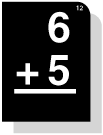 Fractions and Percentages of
Pirates
Fractions and Percentages of
Pirates
Goals:
- The students will describe a group in terms of fractions.
- The students will convert fractions into percentages.
- The students will recognize the percent changes of pirates
throughout the novel Treasure Island.
- The students will draw conclusions regarding the captives' and
pirates' way of thinking as the percentage of pirates decreased
throughout Treasure Island. (Captives' and pirates' way of
thinking will be described in the procedure.)
Resources:
- Copies of the novel Treasure Island by Robert Louis
Stevenson for each student
- Worksheet or examples of problems from student's math book or
other reference material with fractions for the students. (E.g. -
Fraction Action by David A. Alder, Holiday House 1996)
Jelly Beans Paper Pencils
Time:
Depending on how much the students know prior to this lesson about
fractions, the time frame could be anywhere from 1 to 3 hours.
Procedure:
- Students will have already read Treasure Island.
- If students are not familiar with fractions, the teacher can
use direct instruction to explain the concept of breaking up a
group of items into smaller groups. A great way to start this
lesson is to give each student a handful of jelly beans. The
students can group the jelly beans according to color. The process
of finding fractions is a four step process: finding the total
number of items within the group, breaking the entire group into
its parts, counting the number of items in those parts and then
creating the fraction with the part of the group value over the
whole group value.
- Once students understand the concept of fractions, the
students can hunt through the novel to find areas where they
discuss how many characters were pirates and how many were not.
- Students can calculate the percentage of pirates versus the
total number of characters at certain times throughout Treasure
Island. Finding percentages is a two step process once the
students have the fractions. Using the fractions, divide the
numerator by the denominator. Take that answer and multiply by 100
to get the percentage.
- The students will compare their findings at different stages
during Treasure Island.
- If students have not learned the concept of percentages, the
teacher can present a direct instruction lesson of converting
fractions to percentages.
- Students can convert their findings to percentages and compare
their results to other students' results.
- Use this information (Percentages and Fractions) to discuss
the change in mentality of the people on the island. Captive and
pirate mentality might entail some of the following
characteristics: people's choices for which side to join, people's
confidence levels pertaining to finding the treasure. The students
should base these conclusions on the fractions and percents and
the characters' actions from the book. Following the discussion,
the students will write a journal entry drawing conclusions about
the changes in people's mentality as the fractions and percentages
changed.
Assessment:
- The student will hand in their calculations of fractions.
(Criteria for success - Show the six steps to finding fractions
and percentages. The six steps to finding fractions are as
follows:
- Finding the correct number of people at various times
during Treasure Island
- Breaking the total number of people into two groups:
captives and pirates
- Inserting the number of pirates or captives into the
numerator
- Summing the total number of people, captives and pirates,
and placing that number in the denominator
- Dividing the numerator by the denominator to get an answer
in the form of a decimal
- Multiplying that decimal by 100 to calculate the correct
percentage
Credit will be given for each successful step. Steps one and six
will be given ten percent of the total grade while steps two
through five will be given twenty percent of the total grade.
Credit for the correct answer will be given minimal emphasis
because if a student does not find the correct total number of
people, but does the procedure correctly, the student will not
calculate the correct answer. However, the emphasis of this lesson
is to understand and document the procedure. If students start
with the wrong number of pirates or captives and do the procedure
correctly, they should be considered successful.) See steps two
and four in the procedure for more information regarding the steps
to finding percentages.
- The students will write a journal entry. (Criteria for success
= Students will use examples of fractions and percentages they
calculated to explain in their own words the changes in the
characters' mentality in Treasure Island. Teacher's
comments on the journal entries would be greatly beneficial for
the students.)
Curricular Strands and Major Concept:
- Language Arts - Reading the novel Treasure
Island and creating a journal entry by drawing conclusions
from fractions and the novel's context clues..
- Math - Calculating fractions and percentages from clues
in Treasure Island.
Possible Extensions:
- Have students write their own story problems that involve
fractions and percentages.
- This lesson can be replicated with any novel or movie that
contains changes in the numbers involved in groups. (E.g. - The
movie: Alive)
Go to:
Schedule
of Summary Lessons
Lesson Plans List
 Fractions and Percentages of
Pirates
Fractions and Percentages of
Pirates Fractions and Percentages of
Pirates
Fractions and Percentages of
Pirates